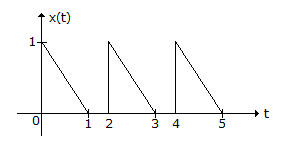ECE :: Exam Questions Paper
-
In orthogonal BFSK. the energy of information bearing term is :
-
The maximum positive and negative numbers which can be represented in 2's complement form using n bits are respectively
-
What is the chemical bonding in silicon semiconductor?
-
The probability density function of the envelope of narrow band noise is :
-
If (10)x x (10)x = (100)x; (100)x x (100)x = (10000)x then x can take value :
-
In a uniformly doped BJT, assume that NE, NB and NC are the emitter, base and collector dopings in atoms/cm3, respectively. If the emitter injection efficiency of the BJT is close unity, which one of the following conditions is TRUE?
-
Consider the following statements about ultrasonic flow meters:
- The measurement in insensitive to viscosity, pressure and temperature variations.
- It has bidirectional measuring capability and can be used for any pipe size.
- It has a relatively lower cost.
- It has good accuracy, fast response and wide frequency range.
-
The number of essential prime implicant for the logic expression
F = ABC + C D A + CDA + ABC + BD


 Whatsapp
Whatsapp
 Facebook
Facebook






